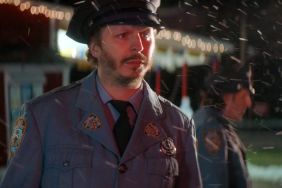
This May brings a remake of early 80s all-timer, Poltergeist, the latest in a long (long) line of cinematic reboots, retreads and more. By now, the ubiquity of reimaginings has rendered their existence less of a transgression than ever, with Poltergeist barely getting anyone up in arms. At the same time, the concept of remakes is an ever-hot point of contention among genre fans. Refusing to indulge in broad dismissaland maybe in a bit of cautious optimismwell spend this May looking at, and defending, some of the better redos in horror cinema.
Its hard to believe its been almost a decade since Billy Lenz escaped from Clark Sanitarium on Christmas Eve.
2006s Black Christmas seems determined to distance itself from Bob Clarks seminal 1974 slasher with immediacy. It opens with a nod to its predecessors infamous suffocation murder before obliterating it with a plunging blade to a victims eye, and a smash cut to the title card. With that, director Glen Morgans slayride positions itself as a different animal entirely.
The originals rocking chair iconography is also trotted out and put into play, but this isnt an instance of filmmakers reusing revered elements out of obligation (why, for example, does remake Freddy require a bladed glove if hes a child molester who never killed his victims?). Instead, Morgan places his veneration for the original upfront before choosing to do something else entirely with this story of sorority sisters besieged by a maniac (or two).
The something else that Morgan chose is perhaps the problem for many, but is there any way to rival the slow burn creepiness that defines the original? Trading subtlety for audacity, this Black Christmas takes the names growled during the originals obscene phone call tirade, Billy and Agnes, and transforms them into an incestuous killer duo. Morgan isnt concerned with mystery, dragging bloody murder to the forefront with a sardonic wink.
Black Christmas has a ball playing with subgenre tropes. Most slashers establish a past tragedy or mishap as the catalyst for putting our antagonist on the path to murder, and heres no different. The isolated sorority house is marked with the sordid history of our killers, whose origins are depicted with tasteless relish. A series of flashbacks show our resident slasher, Billy Lenz, traumatized by his fathers Christmas Eve murder (at the hands of his mother and her sleazy boyfriend, no less), and his fate is further solidified by mommys continued physical and sexual abuse. Morgan makes moments like the breaking of Christmas ornaments over a babys head just over-the-top enough to be digested without offense, as these people arent characters so much as caricatures on a stage of white trash grand guignol.
From this unholy union springs little Agnes. While Billy remains locked away, driven deeper into resentful madness by the familys adoration of the girl, Agnes gets as much love as this vile household can afford. But Billy slips out one Christmas Eve, attacking Agnes with time enough to gouge a single eye. His mother and her boyfriend are butchered for their intervention. During the struggle, and with the literal scratch of a record, Billy and Agnes fates are etched forever into that moment, living only to relive that night.
Morgan embraces the storys absurdity, presenting not one, but two killers driven by ocular disdain. For Billy, its a reminder of glimpsed childhood misery, not only of his fathers killing, but also of time spent spying on a happier family across the streeta reminder of life beyond his means. Agnes, on the other hand, takes revenge on those whove got their eyes, destroying as many as she can manage. And if the point isnt hammered home, their surname, Lenz, certainly drives the nail. This stuff is, of course, Morgan playing up to the leering eyeball imagery of the original movie, but in a way that avoids direct comparison.
Moments like the killer taunting a sanitarium guard by passing a note reading Ill be home for Christmas, and using a sharpened candy cane as an implement of escape are funny, but the kills remain appropriately nasty. Theres no shortage of eyes stabbed, gouged, and eaten, and bodies are dragged off by their leaking, eyeless cavities. Heads are split by sharpened ice skates and three-pronged cultivators. This couldve stood a little more variety in its kills, but it doesnt skimp on the violence.

Cynicism runs through the center of Black Christmas, but Morgan avoids playing the material for straight-up laughs. The humor comes entirely from his palette, the way scenes are structured, shot, and cut, and he smartly refuses his cast permission to step inside the joke.
Thats also true of his handling of the Christmas holiday itself. Here, no one seems all that thrilled by the idea of celebrating. Theres a ring of presents underneath the tree that nobody wants to unwrap, and everyone seems exhausted by the idea of traveling someplace else to spend time with their loved ones. To juxtapose this, Morgan fills every frame with Christmas decorations, scoring a half dozen scenes to holiday carols so to force that exasperation upon all of us. Christmas is inescapable, whether youre celebrating or not.
In a warped way, this rampant Yuletide atmosphere makes it the perfect holiday movie for capturing the way many of us anticipate the seasonwith equal parts joy and dread. Factor in that everyones trapped by a devastating blizzard, and youve got a movie that oozes with more than just Christmas feeling, but also the oppressive isolation of Eastern winters, where even a few blocks can be too far to go for help.
None of this would work without a good cast, and Black Christmas is uniformly strong. Upon introduction, it appears that Morgan is propagating the cliché of unlikable horror movie fodderpeople who deserve to die for being jerks. The first ensemble scene finds each girl seemingly bitchier than the last, but one of the movies strengths is how well the actors acclimate to their characters, matching the directors desired tone without so much as a wink.

It may seem at first that theyre too self-absorbed in their own holiday malaise to care about anything more, but this first impression feels deliberately designed to keep viewer equilibrium askew. During a first viewing, its difficult to determine who will survive, as certain characters display more personality than expected. Here, the nice girl might not make it to the end, while the bitch could be more than that. This is still a slasher movie clocking in at 84 minutes, so its hardly the stuff of fulfilling character arcs, but theres an unconventional approach to the victim convention that makes Black Christmas notable among its modern day peers.
The original films Andrea Martin returns, this time as a harried housemother struggling to keep the girls together, while her disdain for them slips steadily through the corners of her performance.
Kristen Cloke is also fun as an ex-sorority girl looking for her younger sister (who was killed in the opening scene). She personifies everything this movie says about the holiday, incredibly annoyed to be there at first, but eventually setting aside her inconvenience to evolve into a resourceful protector as the girls disappear. Her fuck you, Santa Claus! is kind of the movie in a nutshell.
And the college girls are pretty fun and likeable, with the aforementioned subversion of stereotypes most welcome. For example, Melissa (Michelle Tratchenbeg) seems the callous sort, cold and disconnected from everything, but once Lauren (Crystal Lowe) has indulged in too much wine, she spends much of the night looking after her, putting her to bed and even refusing to leave her side once the others girls realize theyre in danger.
That kind of a tightrope act is never easy (just look at the glut of slashers made each year that strive for old school and succeed only at annoying), but Black Christmas walks it with its style and performances stepping firmly in sync. Morgan delivers one of the most colorful and memorable efforts of the modern slasher era. Its a movie that never bothers to mask its remake origins, outright declining the challenge to match Bob Clarks skin-crawling mastery, favoring instead jaundiced killers and flesh cookies. Thanks to Glen Morgan & co., the night Billy Lenz came home is just one more reason its the most wonderful time of the year.
—
Matt Serafini writes horror fiction and spends much of his free time tracking down obscure slasher movies, ranting about them to whoever will listen. He also likes scotch, and, as such, hopes to find himself embroiled in a real-life giallo one day. Find him on Twitter @MattFini.









